Analysis of Accounting Theory and Current Issues at Woolworths Ltd
VerifiedAdded on 2020/03/23
|15
|4498
|159
Report
AI Summary
This report provides a comprehensive analysis of Woolworths Ltd's accounting practices, focusing on accounting theory and current issues. It begins with an executive summary outlining the importance of consistent accounting policies for effective organizational performance and relevant information disclosure. The report then delves into an assessment of Woolworths' accounting policies and estimates, including depreciation of PPE, treatment of borrowings and intangibles, and compliance with AASB 101 standards. It critically evaluates the accounting quality, considering the political pressures influencing the accounting environment and the impact of accounting choices on stakeholders. Key accounting policies, such as those related to liquidity, market, and credit risks, are examined. The report assesses accounting flexibility, evaluates accounting strategy, and scrutinizes disclosure quality, highlighting any red flags. Finally, it addresses the company's compliance with the conceptual framework. The report concludes by summarizing the key findings and providing a reference list of the sources used.
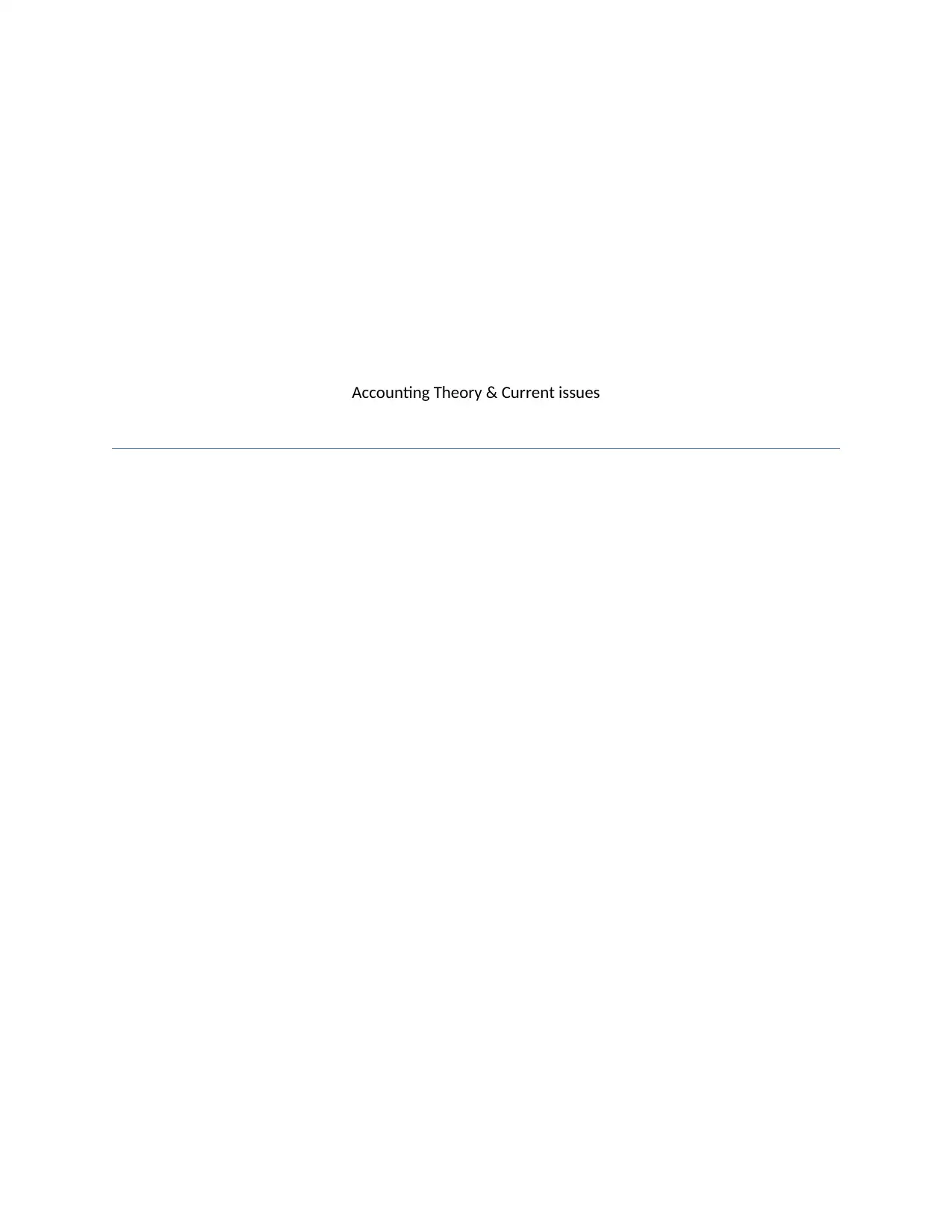
Accounting Theory & Current issues
Paraphrase This Document
Need a fresh take? Get an instant paraphrase of this document with our AI Paraphraser
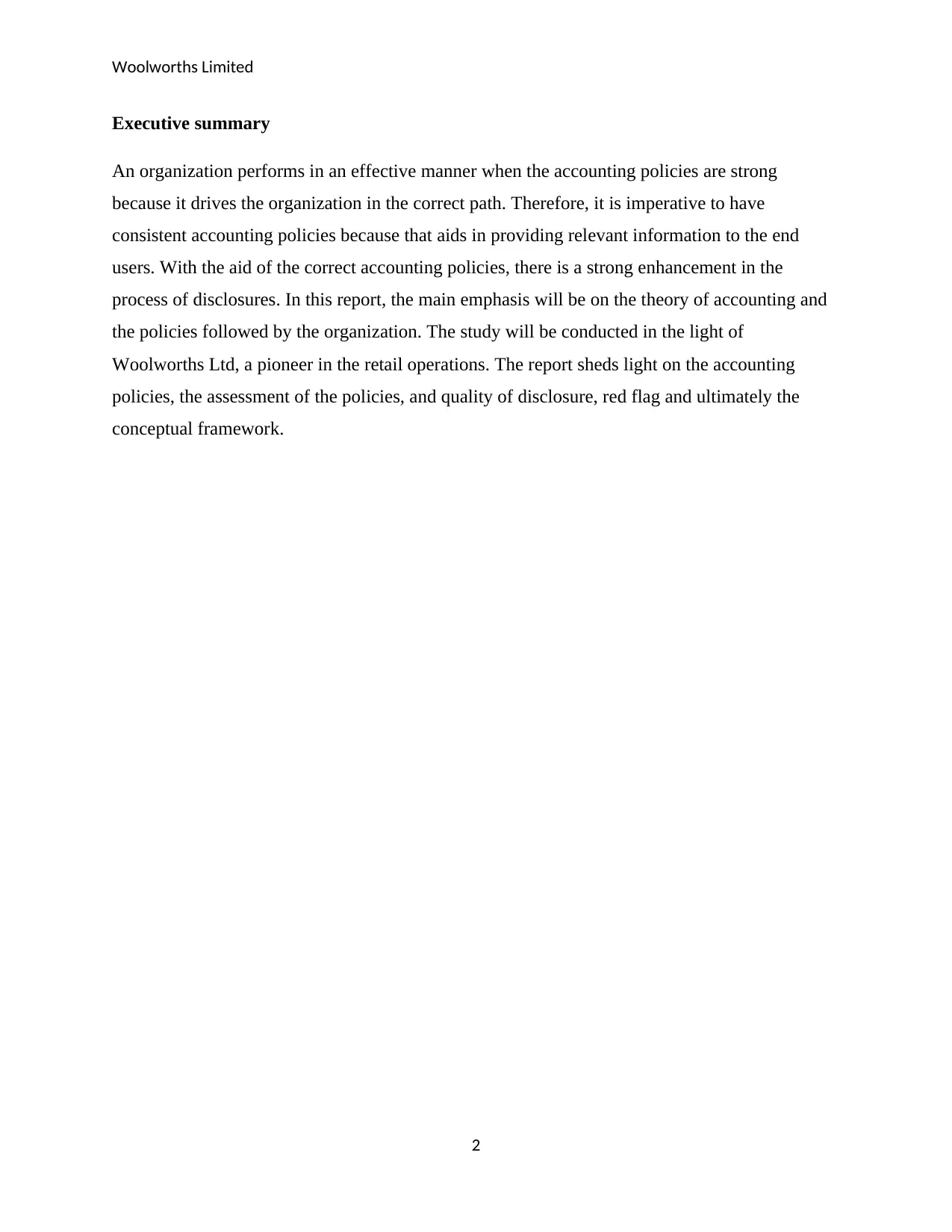
Woolworths Limited
Executive summary
An organization performs in an effective manner when the accounting policies are strong
because it drives the organization in the correct path. Therefore, it is imperative to have
consistent accounting policies because that aids in providing relevant information to the end
users. With the aid of the correct accounting policies, there is a strong enhancement in the
process of disclosures. In this report, the main emphasis will be on the theory of accounting and
the policies followed by the organization. The study will be conducted in the light of
Woolworths Ltd, a pioneer in the retail operations. The report sheds light on the accounting
policies, the assessment of the policies, and quality of disclosure, red flag and ultimately the
conceptual framework.
2
Executive summary
An organization performs in an effective manner when the accounting policies are strong
because it drives the organization in the correct path. Therefore, it is imperative to have
consistent accounting policies because that aids in providing relevant information to the end
users. With the aid of the correct accounting policies, there is a strong enhancement in the
process of disclosures. In this report, the main emphasis will be on the theory of accounting and
the policies followed by the organization. The study will be conducted in the light of
Woolworths Ltd, a pioneer in the retail operations. The report sheds light on the accounting
policies, the assessment of the policies, and quality of disclosure, red flag and ultimately the
conceptual framework.
2
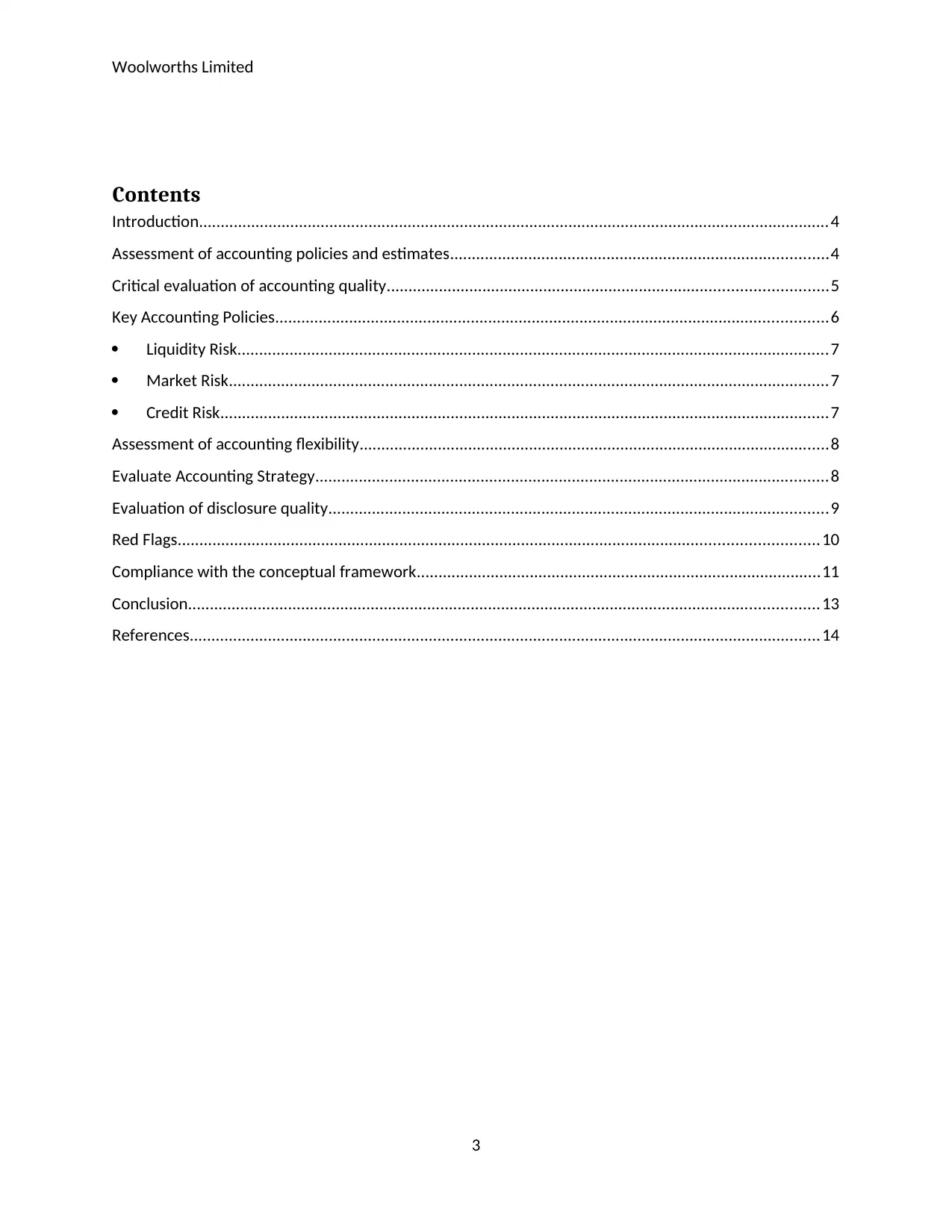
Woolworths Limited
Contents
Introduction.................................................................................................................................................4
Assessment of accounting policies and estimates.......................................................................................4
Critical evaluation of accounting quality.....................................................................................................5
Key Accounting Policies...............................................................................................................................6
Liquidity Risk........................................................................................................................................7
Market Risk..........................................................................................................................................7
Credit Risk............................................................................................................................................7
Assessment of accounting flexibility............................................................................................................8
Evaluate Accounting Strategy......................................................................................................................8
Evaluation of disclosure quality...................................................................................................................9
Red Flags...................................................................................................................................................10
Compliance with the conceptual framework.............................................................................................11
Conclusion.................................................................................................................................................13
References.................................................................................................................................................14
3
Contents
Introduction.................................................................................................................................................4
Assessment of accounting policies and estimates.......................................................................................4
Critical evaluation of accounting quality.....................................................................................................5
Key Accounting Policies...............................................................................................................................6
Liquidity Risk........................................................................................................................................7
Market Risk..........................................................................................................................................7
Credit Risk............................................................................................................................................7
Assessment of accounting flexibility............................................................................................................8
Evaluate Accounting Strategy......................................................................................................................8
Evaluation of disclosure quality...................................................................................................................9
Red Flags...................................................................................................................................................10
Compliance with the conceptual framework.............................................................................................11
Conclusion.................................................................................................................................................13
References.................................................................................................................................................14
3
⊘ This is a preview!⊘
Do you want full access?
Subscribe today to unlock all pages.

Trusted by 1+ million students worldwide
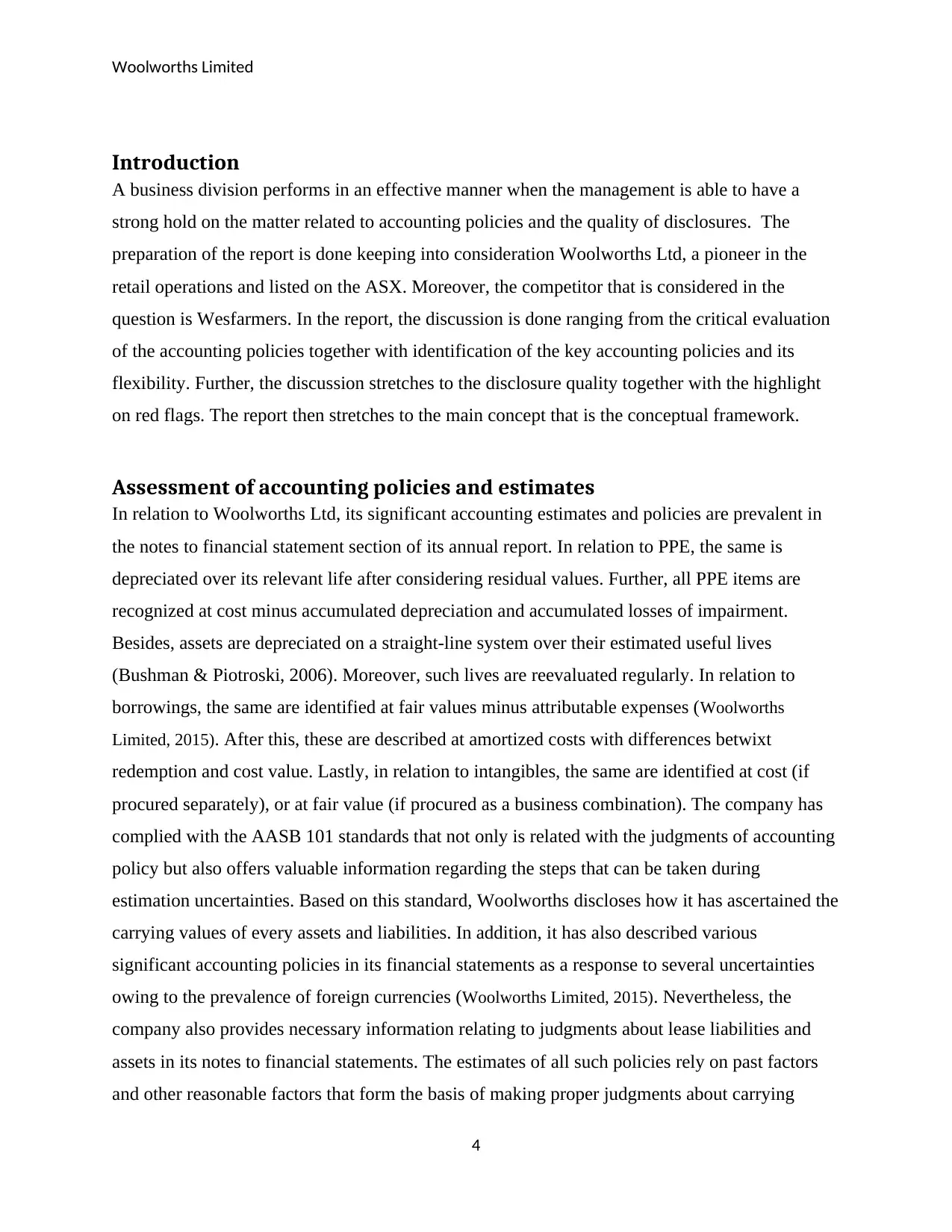
Woolworths Limited
Introduction
A business division performs in an effective manner when the management is able to have a
strong hold on the matter related to accounting policies and the quality of disclosures. The
preparation of the report is done keeping into consideration Woolworths Ltd, a pioneer in the
retail operations and listed on the ASX. Moreover, the competitor that is considered in the
question is Wesfarmers. In the report, the discussion is done ranging from the critical evaluation
of the accounting policies together with identification of the key accounting policies and its
flexibility. Further, the discussion stretches to the disclosure quality together with the highlight
on red flags. The report then stretches to the main concept that is the conceptual framework.
Assessment of accounting policies and estimates
In relation to Woolworths Ltd, its significant accounting estimates and policies are prevalent in
the notes to financial statement section of its annual report. In relation to PPE, the same is
depreciated over its relevant life after considering residual values. Further, all PPE items are
recognized at cost minus accumulated depreciation and accumulated losses of impairment.
Besides, assets are depreciated on a straight-line system over their estimated useful lives
(Bushman & Piotroski, 2006). Moreover, such lives are reevaluated regularly. In relation to
borrowings, the same are identified at fair values minus attributable expenses (Woolworths
Limited, 2015). After this, these are described at amortized costs with differences betwixt
redemption and cost value. Lastly, in relation to intangibles, the same are identified at cost (if
procured separately), or at fair value (if procured as a business combination). The company has
complied with the AASB 101 standards that not only is related with the judgments of accounting
policy but also offers valuable information regarding the steps that can be taken during
estimation uncertainties. Based on this standard, Woolworths discloses how it has ascertained the
carrying values of every assets and liabilities. In addition, it has also described various
significant accounting policies in its financial statements as a response to several uncertainties
owing to the prevalence of foreign currencies (Woolworths Limited, 2015). Nevertheless, the
company also provides necessary information relating to judgments about lease liabilities and
assets in its notes to financial statements. The estimates of all such policies rely on past factors
and other reasonable factors that form the basis of making proper judgments about carrying
4
Introduction
A business division performs in an effective manner when the management is able to have a
strong hold on the matter related to accounting policies and the quality of disclosures. The
preparation of the report is done keeping into consideration Woolworths Ltd, a pioneer in the
retail operations and listed on the ASX. Moreover, the competitor that is considered in the
question is Wesfarmers. In the report, the discussion is done ranging from the critical evaluation
of the accounting policies together with identification of the key accounting policies and its
flexibility. Further, the discussion stretches to the disclosure quality together with the highlight
on red flags. The report then stretches to the main concept that is the conceptual framework.
Assessment of accounting policies and estimates
In relation to Woolworths Ltd, its significant accounting estimates and policies are prevalent in
the notes to financial statement section of its annual report. In relation to PPE, the same is
depreciated over its relevant life after considering residual values. Further, all PPE items are
recognized at cost minus accumulated depreciation and accumulated losses of impairment.
Besides, assets are depreciated on a straight-line system over their estimated useful lives
(Bushman & Piotroski, 2006). Moreover, such lives are reevaluated regularly. In relation to
borrowings, the same are identified at fair values minus attributable expenses (Woolworths
Limited, 2015). After this, these are described at amortized costs with differences betwixt
redemption and cost value. Lastly, in relation to intangibles, the same are identified at cost (if
procured separately), or at fair value (if procured as a business combination). The company has
complied with the AASB 101 standards that not only is related with the judgments of accounting
policy but also offers valuable information regarding the steps that can be taken during
estimation uncertainties. Based on this standard, Woolworths discloses how it has ascertained the
carrying values of every assets and liabilities. In addition, it has also described various
significant accounting policies in its financial statements as a response to several uncertainties
owing to the prevalence of foreign currencies (Woolworths Limited, 2015). Nevertheless, the
company also provides necessary information relating to judgments about lease liabilities and
assets in its notes to financial statements. The estimates of all such policies rely on past factors
and other reasonable factors that form the basis of making proper judgments about carrying
4
Paraphrase This Document
Need a fresh take? Get an instant paraphrase of this document with our AI Paraphraser
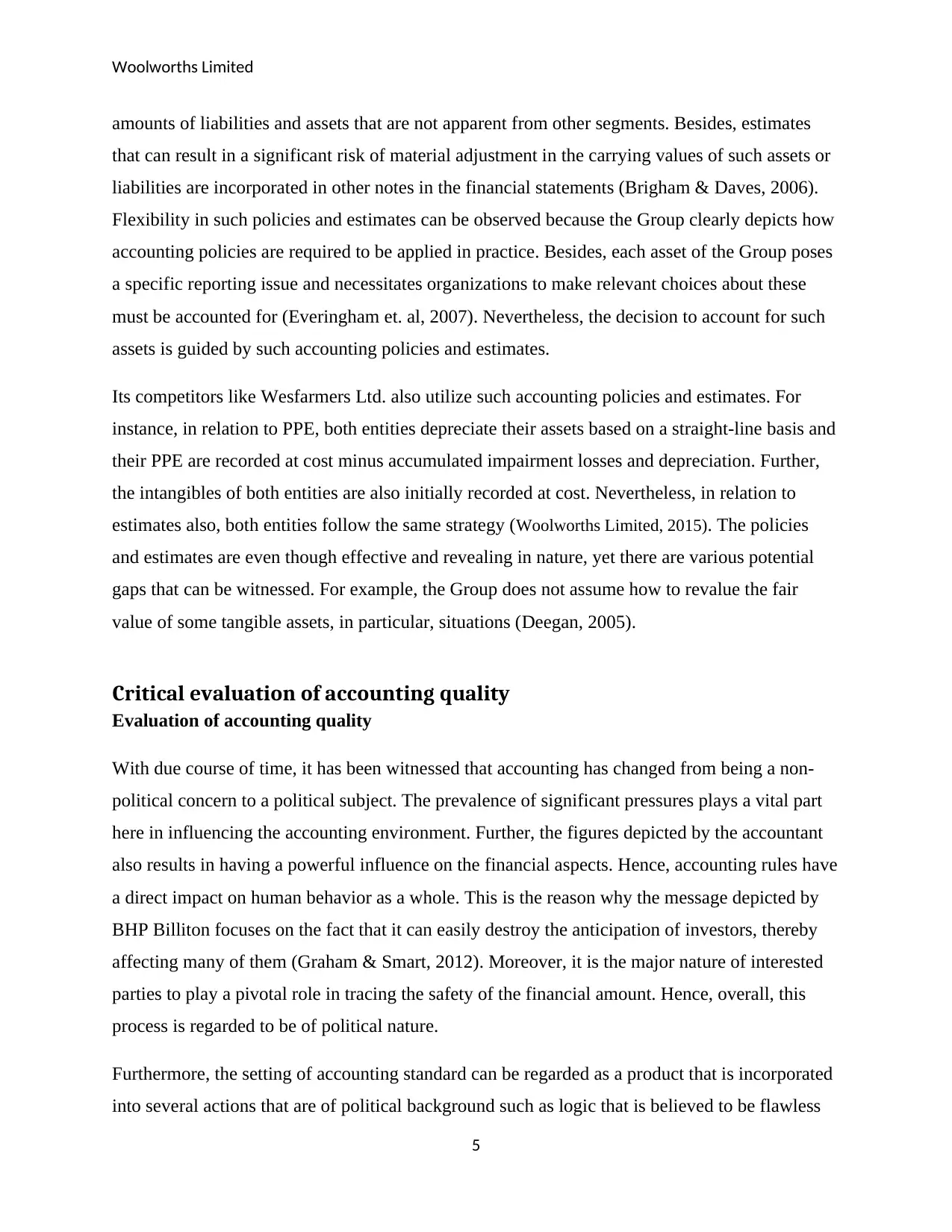
Woolworths Limited
amounts of liabilities and assets that are not apparent from other segments. Besides, estimates
that can result in a significant risk of material adjustment in the carrying values of such assets or
liabilities are incorporated in other notes in the financial statements (Brigham & Daves, 2006).
Flexibility in such policies and estimates can be observed because the Group clearly depicts how
accounting policies are required to be applied in practice. Besides, each asset of the Group poses
a specific reporting issue and necessitates organizations to make relevant choices about these
must be accounted for (Everingham et. al, 2007). Nevertheless, the decision to account for such
assets is guided by such accounting policies and estimates.
Its competitors like Wesfarmers Ltd. also utilize such accounting policies and estimates. For
instance, in relation to PPE, both entities depreciate their assets based on a straight-line basis and
their PPE are recorded at cost minus accumulated impairment losses and depreciation. Further,
the intangibles of both entities are also initially recorded at cost. Nevertheless, in relation to
estimates also, both entities follow the same strategy (Woolworths Limited, 2015). The policies
and estimates are even though effective and revealing in nature, yet there are various potential
gaps that can be witnessed. For example, the Group does not assume how to revalue the fair
value of some tangible assets, in particular, situations (Deegan, 2005).
Critical evaluation of accounting quality
Evaluation of accounting quality
With due course of time, it has been witnessed that accounting has changed from being a non-
political concern to a political subject. The prevalence of significant pressures plays a vital part
here in influencing the accounting environment. Further, the figures depicted by the accountant
also results in having a powerful influence on the financial aspects. Hence, accounting rules have
a direct impact on human behavior as a whole. This is the reason why the message depicted by
BHP Billiton focuses on the fact that it can easily destroy the anticipation of investors, thereby
affecting many of them (Graham & Smart, 2012). Moreover, it is the major nature of interested
parties to play a pivotal role in tracing the safety of the financial amount. Hence, overall, this
process is regarded to be of political nature.
Furthermore, the setting of accounting standard can be regarded as a product that is incorporated
into several actions that are of political background such as logic that is believed to be flawless
5
amounts of liabilities and assets that are not apparent from other segments. Besides, estimates
that can result in a significant risk of material adjustment in the carrying values of such assets or
liabilities are incorporated in other notes in the financial statements (Brigham & Daves, 2006).
Flexibility in such policies and estimates can be observed because the Group clearly depicts how
accounting policies are required to be applied in practice. Besides, each asset of the Group poses
a specific reporting issue and necessitates organizations to make relevant choices about these
must be accounted for (Everingham et. al, 2007). Nevertheless, the decision to account for such
assets is guided by such accounting policies and estimates.
Its competitors like Wesfarmers Ltd. also utilize such accounting policies and estimates. For
instance, in relation to PPE, both entities depreciate their assets based on a straight-line basis and
their PPE are recorded at cost minus accumulated impairment losses and depreciation. Further,
the intangibles of both entities are also initially recorded at cost. Nevertheless, in relation to
estimates also, both entities follow the same strategy (Woolworths Limited, 2015). The policies
and estimates are even though effective and revealing in nature, yet there are various potential
gaps that can be witnessed. For example, the Group does not assume how to revalue the fair
value of some tangible assets, in particular, situations (Deegan, 2005).
Critical evaluation of accounting quality
Evaluation of accounting quality
With due course of time, it has been witnessed that accounting has changed from being a non-
political concern to a political subject. The prevalence of significant pressures plays a vital part
here in influencing the accounting environment. Further, the figures depicted by the accountant
also results in having a powerful influence on the financial aspects. Hence, accounting rules have
a direct impact on human behavior as a whole. This is the reason why the message depicted by
BHP Billiton focuses on the fact that it can easily destroy the anticipation of investors, thereby
affecting many of them (Graham & Smart, 2012). Moreover, it is the major nature of interested
parties to play a pivotal role in tracing the safety of the financial amount. Hence, overall, this
process is regarded to be of political nature.
Furthermore, the setting of accounting standard can be regarded as a product that is incorporated
into several actions that are of political background such as logic that is believed to be flawless
5
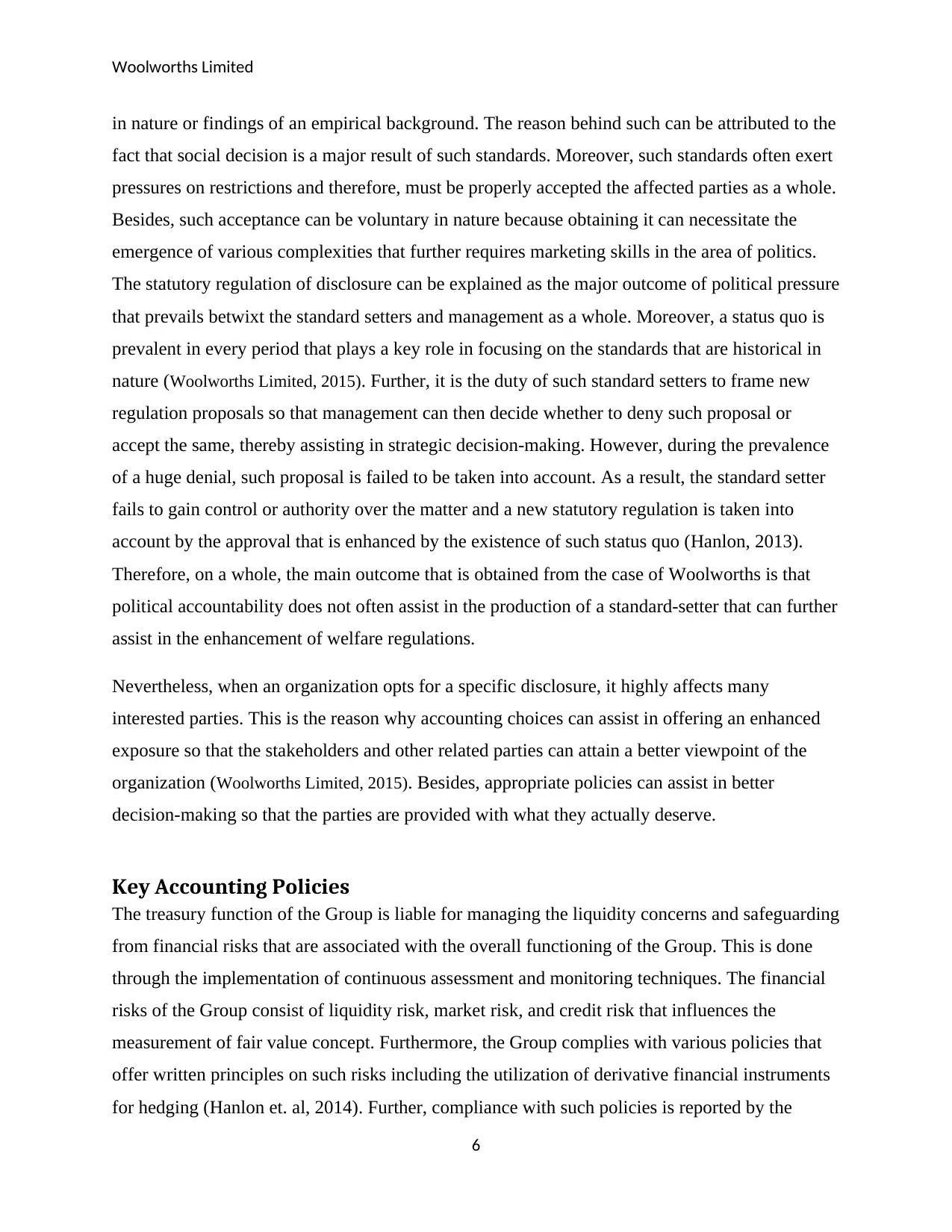
Woolworths Limited
in nature or findings of an empirical background. The reason behind such can be attributed to the
fact that social decision is a major result of such standards. Moreover, such standards often exert
pressures on restrictions and therefore, must be properly accepted the affected parties as a whole.
Besides, such acceptance can be voluntary in nature because obtaining it can necessitate the
emergence of various complexities that further requires marketing skills in the area of politics.
The statutory regulation of disclosure can be explained as the major outcome of political pressure
that prevails betwixt the standard setters and management as a whole. Moreover, a status quo is
prevalent in every period that plays a key role in focusing on the standards that are historical in
nature (Woolworths Limited, 2015). Further, it is the duty of such standard setters to frame new
regulation proposals so that management can then decide whether to deny such proposal or
accept the same, thereby assisting in strategic decision-making. However, during the prevalence
of a huge denial, such proposal is failed to be taken into account. As a result, the standard setter
fails to gain control or authority over the matter and a new statutory regulation is taken into
account by the approval that is enhanced by the existence of such status quo (Hanlon, 2013).
Therefore, on a whole, the main outcome that is obtained from the case of Woolworths is that
political accountability does not often assist in the production of a standard-setter that can further
assist in the enhancement of welfare regulations.
Nevertheless, when an organization opts for a specific disclosure, it highly affects many
interested parties. This is the reason why accounting choices can assist in offering an enhanced
exposure so that the stakeholders and other related parties can attain a better viewpoint of the
organization (Woolworths Limited, 2015). Besides, appropriate policies can assist in better
decision-making so that the parties are provided with what they actually deserve.
Key Accounting Policies
The treasury function of the Group is liable for managing the liquidity concerns and safeguarding
from financial risks that are associated with the overall functioning of the Group. This is done
through the implementation of continuous assessment and monitoring techniques. The financial
risks of the Group consist of liquidity risk, market risk, and credit risk that influences the
measurement of fair value concept. Furthermore, the Group complies with various policies that
offer written principles on such risks including the utilization of derivative financial instruments
for hedging (Hanlon et. al, 2014). Further, compliance with such policies is reported by the
6
in nature or findings of an empirical background. The reason behind such can be attributed to the
fact that social decision is a major result of such standards. Moreover, such standards often exert
pressures on restrictions and therefore, must be properly accepted the affected parties as a whole.
Besides, such acceptance can be voluntary in nature because obtaining it can necessitate the
emergence of various complexities that further requires marketing skills in the area of politics.
The statutory regulation of disclosure can be explained as the major outcome of political pressure
that prevails betwixt the standard setters and management as a whole. Moreover, a status quo is
prevalent in every period that plays a key role in focusing on the standards that are historical in
nature (Woolworths Limited, 2015). Further, it is the duty of such standard setters to frame new
regulation proposals so that management can then decide whether to deny such proposal or
accept the same, thereby assisting in strategic decision-making. However, during the prevalence
of a huge denial, such proposal is failed to be taken into account. As a result, the standard setter
fails to gain control or authority over the matter and a new statutory regulation is taken into
account by the approval that is enhanced by the existence of such status quo (Hanlon, 2013).
Therefore, on a whole, the main outcome that is obtained from the case of Woolworths is that
political accountability does not often assist in the production of a standard-setter that can further
assist in the enhancement of welfare regulations.
Nevertheless, when an organization opts for a specific disclosure, it highly affects many
interested parties. This is the reason why accounting choices can assist in offering an enhanced
exposure so that the stakeholders and other related parties can attain a better viewpoint of the
organization (Woolworths Limited, 2015). Besides, appropriate policies can assist in better
decision-making so that the parties are provided with what they actually deserve.
Key Accounting Policies
The treasury function of the Group is liable for managing the liquidity concerns and safeguarding
from financial risks that are associated with the overall functioning of the Group. This is done
through the implementation of continuous assessment and monitoring techniques. The financial
risks of the Group consist of liquidity risk, market risk, and credit risk that influences the
measurement of fair value concept. Furthermore, the Group complies with various policies that
offer written principles on such risks including the utilization of derivative financial instruments
for hedging (Hanlon et. al, 2014). Further, compliance with such policies is reported by the
6
⊘ This is a preview!⊘
Do you want full access?
Subscribe today to unlock all pages.

Trusted by 1+ million students worldwide
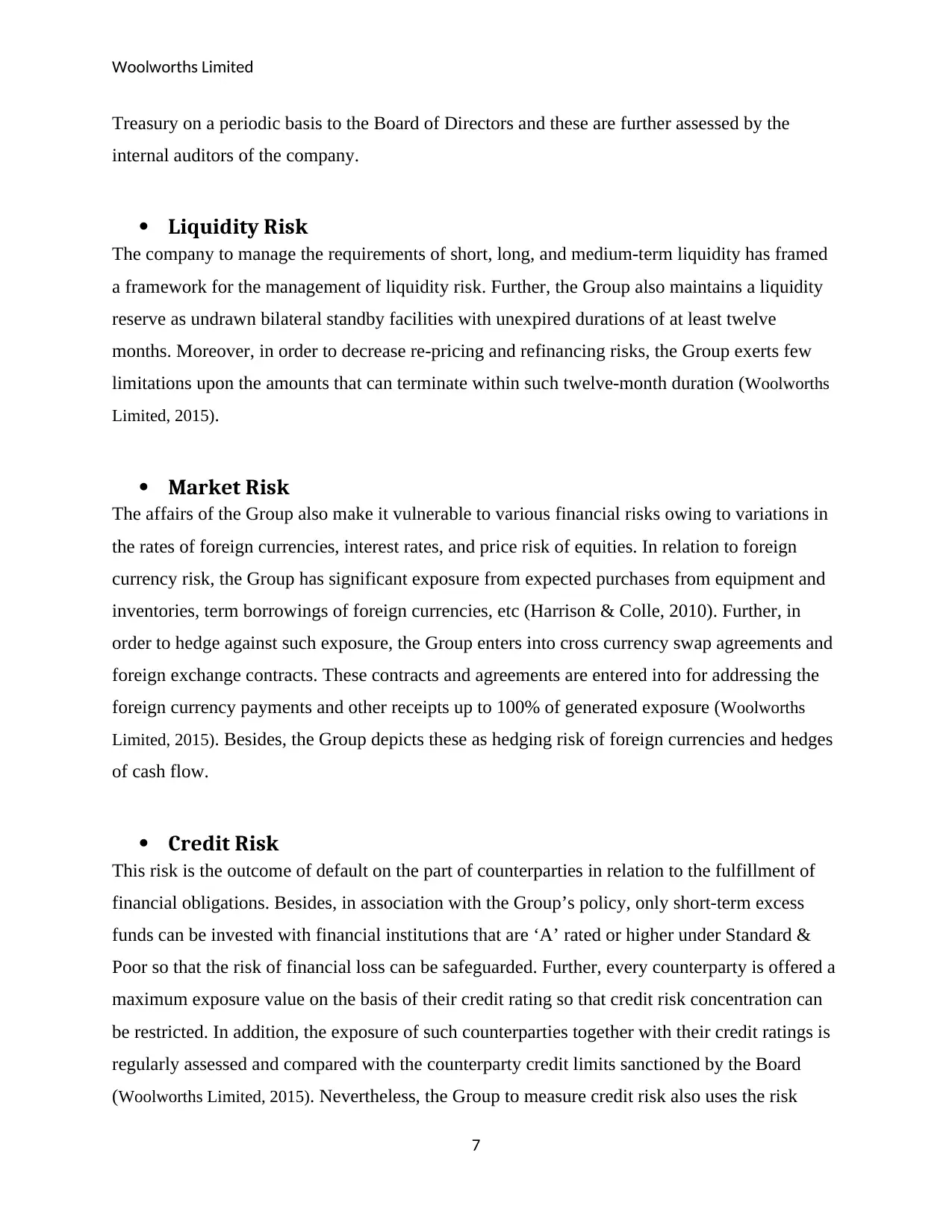
Woolworths Limited
Treasury on a periodic basis to the Board of Directors and these are further assessed by the
internal auditors of the company.
Liquidity Risk
The company to manage the requirements of short, long, and medium-term liquidity has framed
a framework for the management of liquidity risk. Further, the Group also maintains a liquidity
reserve as undrawn bilateral standby facilities with unexpired durations of at least twelve
months. Moreover, in order to decrease re-pricing and refinancing risks, the Group exerts few
limitations upon the amounts that can terminate within such twelve-month duration (Woolworths
Limited, 2015).
Market Risk
The affairs of the Group also make it vulnerable to various financial risks owing to variations in
the rates of foreign currencies, interest rates, and price risk of equities. In relation to foreign
currency risk, the Group has significant exposure from expected purchases from equipment and
inventories, term borrowings of foreign currencies, etc (Harrison & Colle, 2010). Further, in
order to hedge against such exposure, the Group enters into cross currency swap agreements and
foreign exchange contracts. These contracts and agreements are entered into for addressing the
foreign currency payments and other receipts up to 100% of generated exposure (Woolworths
Limited, 2015). Besides, the Group depicts these as hedging risk of foreign currencies and hedges
of cash flow.
Credit Risk
This risk is the outcome of default on the part of counterparties in relation to the fulfillment of
financial obligations. Besides, in association with the Group’s policy, only short-term excess
funds can be invested with financial institutions that are ‘A’ rated or higher under Standard &
Poor so that the risk of financial loss can be safeguarded. Further, every counterparty is offered a
maximum exposure value on the basis of their credit rating so that credit risk concentration can
be restricted. In addition, the exposure of such counterparties together with their credit ratings is
regularly assessed and compared with the counterparty credit limits sanctioned by the Board
(Woolworths Limited, 2015). Nevertheless, the Group to measure credit risk also uses the risk
7
Treasury on a periodic basis to the Board of Directors and these are further assessed by the
internal auditors of the company.
Liquidity Risk
The company to manage the requirements of short, long, and medium-term liquidity has framed
a framework for the management of liquidity risk. Further, the Group also maintains a liquidity
reserve as undrawn bilateral standby facilities with unexpired durations of at least twelve
months. Moreover, in order to decrease re-pricing and refinancing risks, the Group exerts few
limitations upon the amounts that can terminate within such twelve-month duration (Woolworths
Limited, 2015).
Market Risk
The affairs of the Group also make it vulnerable to various financial risks owing to variations in
the rates of foreign currencies, interest rates, and price risk of equities. In relation to foreign
currency risk, the Group has significant exposure from expected purchases from equipment and
inventories, term borrowings of foreign currencies, etc (Harrison & Colle, 2010). Further, in
order to hedge against such exposure, the Group enters into cross currency swap agreements and
foreign exchange contracts. These contracts and agreements are entered into for addressing the
foreign currency payments and other receipts up to 100% of generated exposure (Woolworths
Limited, 2015). Besides, the Group depicts these as hedging risk of foreign currencies and hedges
of cash flow.
Credit Risk
This risk is the outcome of default on the part of counterparties in relation to the fulfillment of
financial obligations. Besides, in association with the Group’s policy, only short-term excess
funds can be invested with financial institutions that are ‘A’ rated or higher under Standard &
Poor so that the risk of financial loss can be safeguarded. Further, every counterparty is offered a
maximum exposure value on the basis of their credit rating so that credit risk concentration can
be restricted. In addition, the exposure of such counterparties together with their credit ratings is
regularly assessed and compared with the counterparty credit limits sanctioned by the Board
(Woolworths Limited, 2015). Nevertheless, the Group to measure credit risk also uses the risk
7
Paraphrase This Document
Need a fresh take? Get an instant paraphrase of this document with our AI Paraphraser
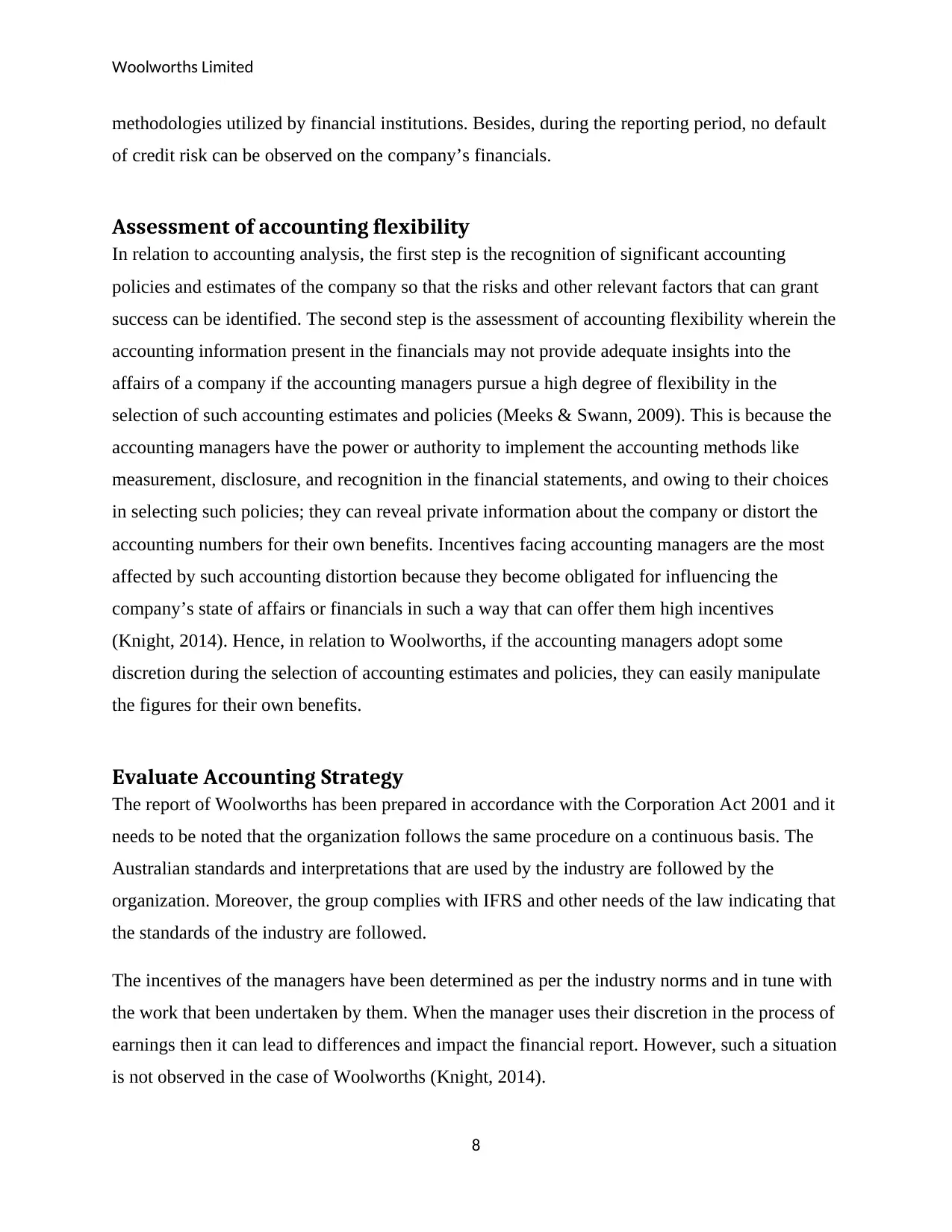
Woolworths Limited
methodologies utilized by financial institutions. Besides, during the reporting period, no default
of credit risk can be observed on the company’s financials.
Assessment of accounting flexibility
In relation to accounting analysis, the first step is the recognition of significant accounting
policies and estimates of the company so that the risks and other relevant factors that can grant
success can be identified. The second step is the assessment of accounting flexibility wherein the
accounting information present in the financials may not provide adequate insights into the
affairs of a company if the accounting managers pursue a high degree of flexibility in the
selection of such accounting estimates and policies (Meeks & Swann, 2009). This is because the
accounting managers have the power or authority to implement the accounting methods like
measurement, disclosure, and recognition in the financial statements, and owing to their choices
in selecting such policies; they can reveal private information about the company or distort the
accounting numbers for their own benefits. Incentives facing accounting managers are the most
affected by such accounting distortion because they become obligated for influencing the
company’s state of affairs or financials in such a way that can offer them high incentives
(Knight, 2014). Hence, in relation to Woolworths, if the accounting managers adopt some
discretion during the selection of accounting estimates and policies, they can easily manipulate
the figures for their own benefits.
Evaluate Accounting Strategy
The report of Woolworths has been prepared in accordance with the Corporation Act 2001 and it
needs to be noted that the organization follows the same procedure on a continuous basis. The
Australian standards and interpretations that are used by the industry are followed by the
organization. Moreover, the group complies with IFRS and other needs of the law indicating that
the standards of the industry are followed.
The incentives of the managers have been determined as per the industry norms and in tune with
the work that been undertaken by them. When the manager uses their discretion in the process of
earnings then it can lead to differences and impact the financial report. However, such a situation
is not observed in the case of Woolworths (Knight, 2014).
8
methodologies utilized by financial institutions. Besides, during the reporting period, no default
of credit risk can be observed on the company’s financials.
Assessment of accounting flexibility
In relation to accounting analysis, the first step is the recognition of significant accounting
policies and estimates of the company so that the risks and other relevant factors that can grant
success can be identified. The second step is the assessment of accounting flexibility wherein the
accounting information present in the financials may not provide adequate insights into the
affairs of a company if the accounting managers pursue a high degree of flexibility in the
selection of such accounting estimates and policies (Meeks & Swann, 2009). This is because the
accounting managers have the power or authority to implement the accounting methods like
measurement, disclosure, and recognition in the financial statements, and owing to their choices
in selecting such policies; they can reveal private information about the company or distort the
accounting numbers for their own benefits. Incentives facing accounting managers are the most
affected by such accounting distortion because they become obligated for influencing the
company’s state of affairs or financials in such a way that can offer them high incentives
(Knight, 2014). Hence, in relation to Woolworths, if the accounting managers adopt some
discretion during the selection of accounting estimates and policies, they can easily manipulate
the figures for their own benefits.
Evaluate Accounting Strategy
The report of Woolworths has been prepared in accordance with the Corporation Act 2001 and it
needs to be noted that the organization follows the same procedure on a continuous basis. The
Australian standards and interpretations that are used by the industry are followed by the
organization. Moreover, the group complies with IFRS and other needs of the law indicating that
the standards of the industry are followed.
The incentives of the managers have been determined as per the industry norms and in tune with
the work that been undertaken by them. When the manager uses their discretion in the process of
earnings then it can lead to differences and impact the financial report. However, such a situation
is not observed in the case of Woolworths (Knight, 2014).
8
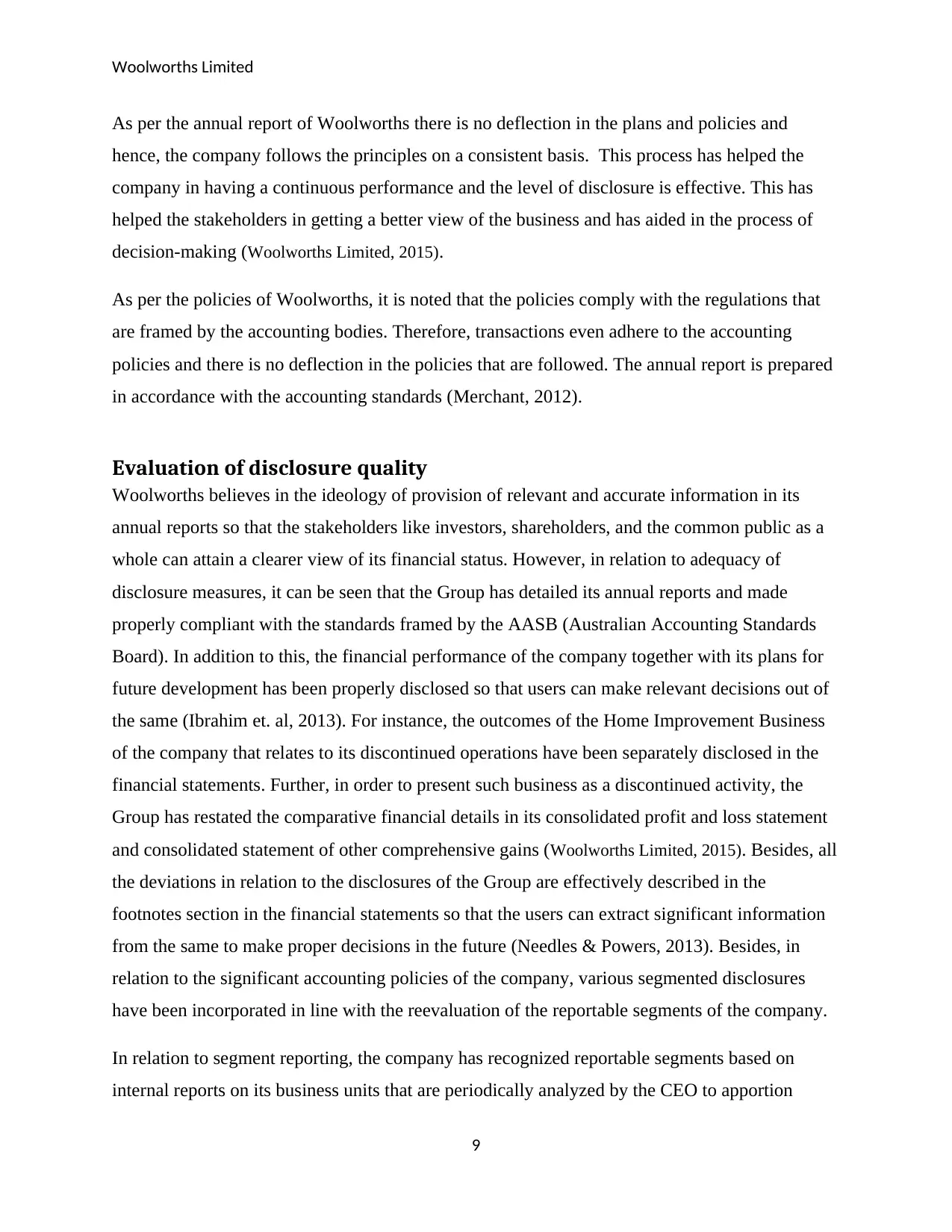
Woolworths Limited
As per the annual report of Woolworths there is no deflection in the plans and policies and
hence, the company follows the principles on a consistent basis. This process has helped the
company in having a continuous performance and the level of disclosure is effective. This has
helped the stakeholders in getting a better view of the business and has aided in the process of
decision-making (Woolworths Limited, 2015).
As per the policies of Woolworths, it is noted that the policies comply with the regulations that
are framed by the accounting bodies. Therefore, transactions even adhere to the accounting
policies and there is no deflection in the policies that are followed. The annual report is prepared
in accordance with the accounting standards (Merchant, 2012).
Evaluation of disclosure quality
Woolworths believes in the ideology of provision of relevant and accurate information in its
annual reports so that the stakeholders like investors, shareholders, and the common public as a
whole can attain a clearer view of its financial status. However, in relation to adequacy of
disclosure measures, it can be seen that the Group has detailed its annual reports and made
properly compliant with the standards framed by the AASB (Australian Accounting Standards
Board). In addition to this, the financial performance of the company together with its plans for
future development has been properly disclosed so that users can make relevant decisions out of
the same (Ibrahim et. al, 2013). For instance, the outcomes of the Home Improvement Business
of the company that relates to its discontinued operations have been separately disclosed in the
financial statements. Further, in order to present such business as a discontinued activity, the
Group has restated the comparative financial details in its consolidated profit and loss statement
and consolidated statement of other comprehensive gains (Woolworths Limited, 2015). Besides, all
the deviations in relation to the disclosures of the Group are effectively described in the
footnotes section in the financial statements so that the users can extract significant information
from the same to make proper decisions in the future (Needles & Powers, 2013). Besides, in
relation to the significant accounting policies of the company, various segmented disclosures
have been incorporated in line with the reevaluation of the reportable segments of the company.
In relation to segment reporting, the company has recognized reportable segments based on
internal reports on its business units that are periodically analyzed by the CEO to apportion
9
As per the annual report of Woolworths there is no deflection in the plans and policies and
hence, the company follows the principles on a consistent basis. This process has helped the
company in having a continuous performance and the level of disclosure is effective. This has
helped the stakeholders in getting a better view of the business and has aided in the process of
decision-making (Woolworths Limited, 2015).
As per the policies of Woolworths, it is noted that the policies comply with the regulations that
are framed by the accounting bodies. Therefore, transactions even adhere to the accounting
policies and there is no deflection in the policies that are followed. The annual report is prepared
in accordance with the accounting standards (Merchant, 2012).
Evaluation of disclosure quality
Woolworths believes in the ideology of provision of relevant and accurate information in its
annual reports so that the stakeholders like investors, shareholders, and the common public as a
whole can attain a clearer view of its financial status. However, in relation to adequacy of
disclosure measures, it can be seen that the Group has detailed its annual reports and made
properly compliant with the standards framed by the AASB (Australian Accounting Standards
Board). In addition to this, the financial performance of the company together with its plans for
future development has been properly disclosed so that users can make relevant decisions out of
the same (Ibrahim et. al, 2013). For instance, the outcomes of the Home Improvement Business
of the company that relates to its discontinued operations have been separately disclosed in the
financial statements. Further, in order to present such business as a discontinued activity, the
Group has restated the comparative financial details in its consolidated profit and loss statement
and consolidated statement of other comprehensive gains (Woolworths Limited, 2015). Besides, all
the deviations in relation to the disclosures of the Group are effectively described in the
footnotes section in the financial statements so that the users can extract significant information
from the same to make proper decisions in the future (Needles & Powers, 2013). Besides, in
relation to the significant accounting policies of the company, various segmented disclosures
have been incorporated in line with the reevaluation of the reportable segments of the company.
In relation to segment reporting, the company has recognized reportable segments based on
internal reports on its business units that are periodically analyzed by the CEO to apportion
9
⊘ This is a preview!⊘
Do you want full access?
Subscribe today to unlock all pages.

Trusted by 1+ million students worldwide
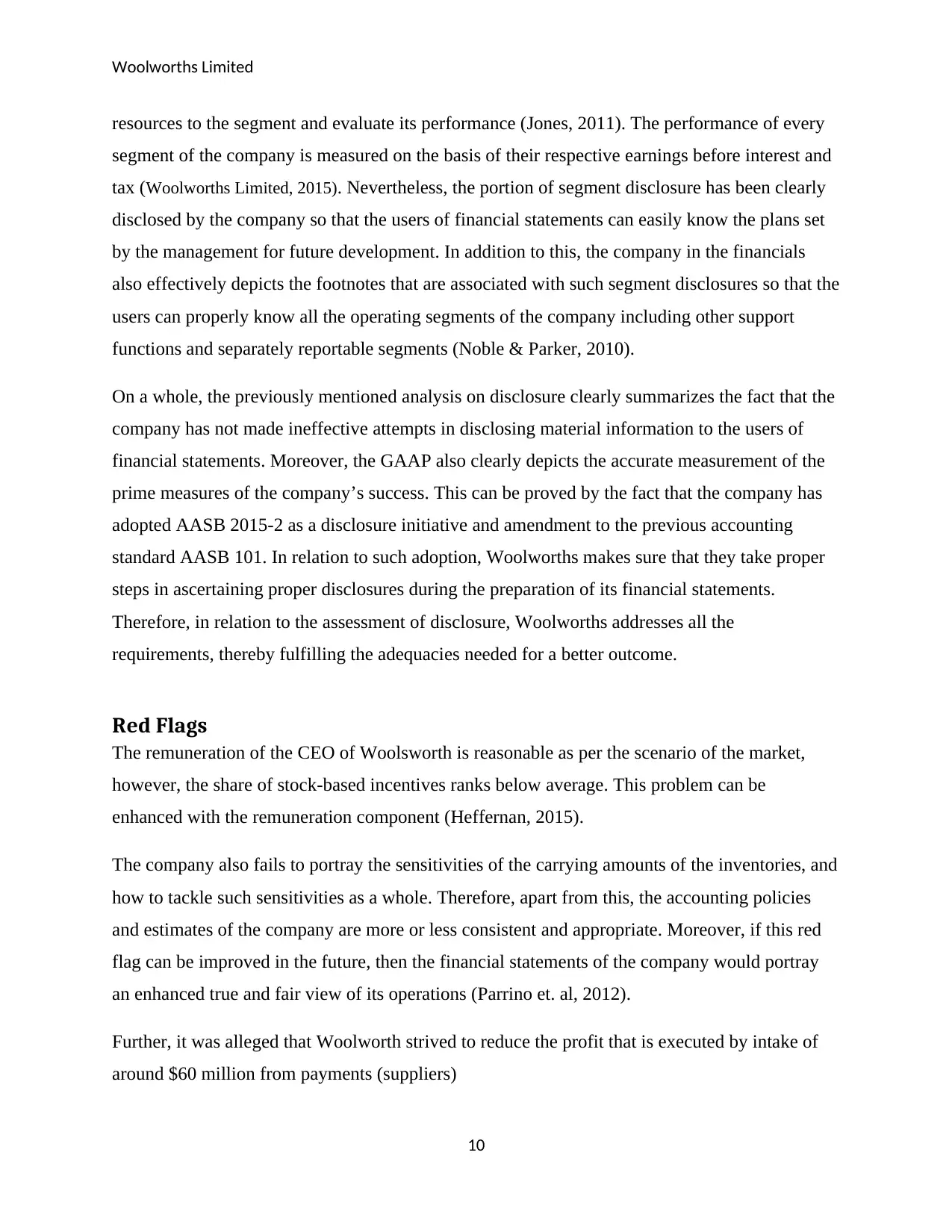
Woolworths Limited
resources to the segment and evaluate its performance (Jones, 2011). The performance of every
segment of the company is measured on the basis of their respective earnings before interest and
tax (Woolworths Limited, 2015). Nevertheless, the portion of segment disclosure has been clearly
disclosed by the company so that the users of financial statements can easily know the plans set
by the management for future development. In addition to this, the company in the financials
also effectively depicts the footnotes that are associated with such segment disclosures so that the
users can properly know all the operating segments of the company including other support
functions and separately reportable segments (Noble & Parker, 2010).
On a whole, the previously mentioned analysis on disclosure clearly summarizes the fact that the
company has not made ineffective attempts in disclosing material information to the users of
financial statements. Moreover, the GAAP also clearly depicts the accurate measurement of the
prime measures of the company’s success. This can be proved by the fact that the company has
adopted AASB 2015-2 as a disclosure initiative and amendment to the previous accounting
standard AASB 101. In relation to such adoption, Woolworths makes sure that they take proper
steps in ascertaining proper disclosures during the preparation of its financial statements.
Therefore, in relation to the assessment of disclosure, Woolworths addresses all the
requirements, thereby fulfilling the adequacies needed for a better outcome.
Red Flags
The remuneration of the CEO of Woolsworth is reasonable as per the scenario of the market,
however, the share of stock-based incentives ranks below average. This problem can be
enhanced with the remuneration component (Heffernan, 2015).
The company also fails to portray the sensitivities of the carrying amounts of the inventories, and
how to tackle such sensitivities as a whole. Therefore, apart from this, the accounting policies
and estimates of the company are more or less consistent and appropriate. Moreover, if this red
flag can be improved in the future, then the financial statements of the company would portray
an enhanced true and fair view of its operations (Parrino et. al, 2012).
Further, it was alleged that Woolworth strived to reduce the profit that is executed by intake of
around $60 million from payments (suppliers)
10
resources to the segment and evaluate its performance (Jones, 2011). The performance of every
segment of the company is measured on the basis of their respective earnings before interest and
tax (Woolworths Limited, 2015). Nevertheless, the portion of segment disclosure has been clearly
disclosed by the company so that the users of financial statements can easily know the plans set
by the management for future development. In addition to this, the company in the financials
also effectively depicts the footnotes that are associated with such segment disclosures so that the
users can properly know all the operating segments of the company including other support
functions and separately reportable segments (Noble & Parker, 2010).
On a whole, the previously mentioned analysis on disclosure clearly summarizes the fact that the
company has not made ineffective attempts in disclosing material information to the users of
financial statements. Moreover, the GAAP also clearly depicts the accurate measurement of the
prime measures of the company’s success. This can be proved by the fact that the company has
adopted AASB 2015-2 as a disclosure initiative and amendment to the previous accounting
standard AASB 101. In relation to such adoption, Woolworths makes sure that they take proper
steps in ascertaining proper disclosures during the preparation of its financial statements.
Therefore, in relation to the assessment of disclosure, Woolworths addresses all the
requirements, thereby fulfilling the adequacies needed for a better outcome.
Red Flags
The remuneration of the CEO of Woolsworth is reasonable as per the scenario of the market,
however, the share of stock-based incentives ranks below average. This problem can be
enhanced with the remuneration component (Heffernan, 2015).
The company also fails to portray the sensitivities of the carrying amounts of the inventories, and
how to tackle such sensitivities as a whole. Therefore, apart from this, the accounting policies
and estimates of the company are more or less consistent and appropriate. Moreover, if this red
flag can be improved in the future, then the financial statements of the company would portray
an enhanced true and fair view of its operations (Parrino et. al, 2012).
Further, it was alleged that Woolworth strived to reduce the profit that is executed by intake of
around $60 million from payments (suppliers)
10
Paraphrase This Document
Need a fresh take? Get an instant paraphrase of this document with our AI Paraphraser
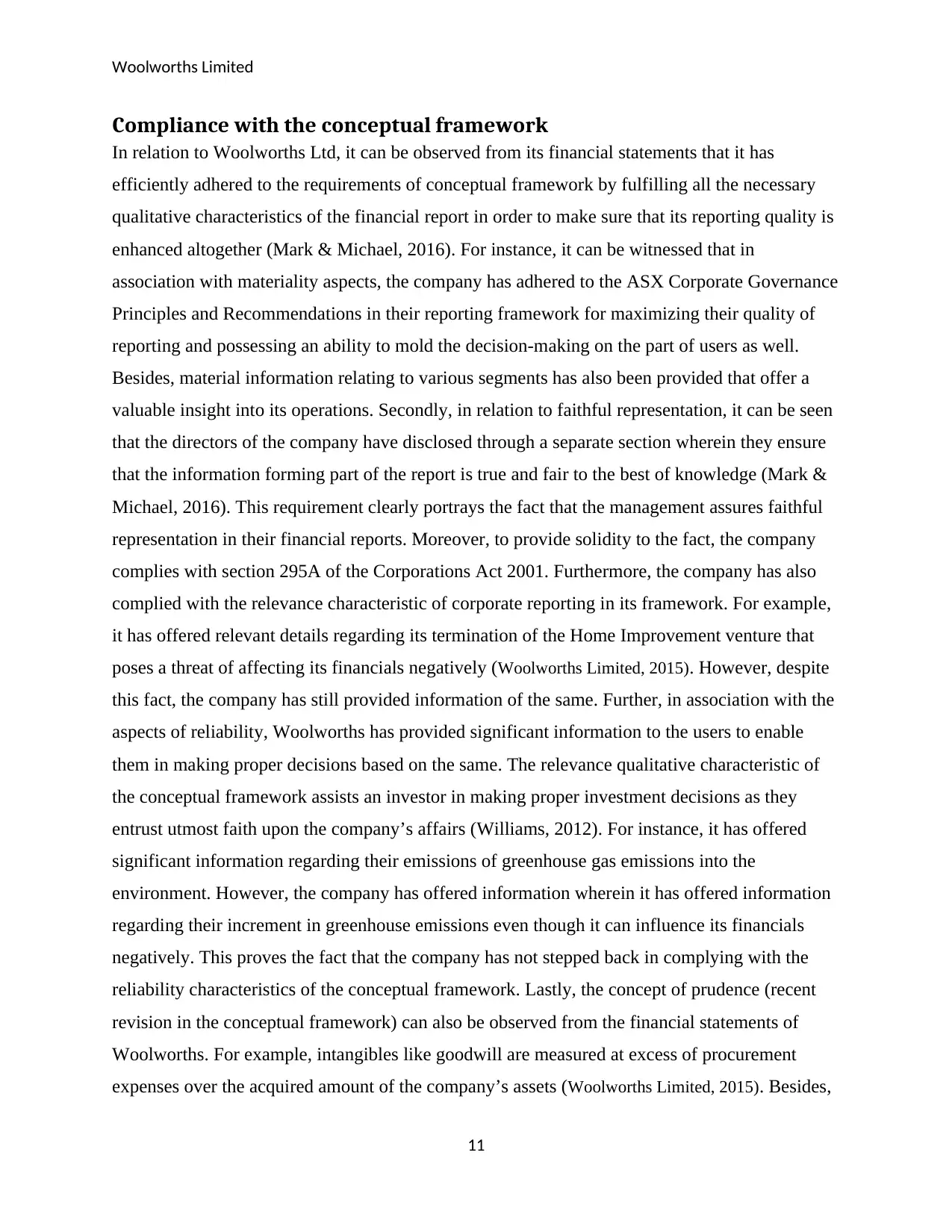
Woolworths Limited
Compliance with the conceptual framework
In relation to Woolworths Ltd, it can be observed from its financial statements that it has
efficiently adhered to the requirements of conceptual framework by fulfilling all the necessary
qualitative characteristics of the financial report in order to make sure that its reporting quality is
enhanced altogether (Mark & Michael, 2016). For instance, it can be witnessed that in
association with materiality aspects, the company has adhered to the ASX Corporate Governance
Principles and Recommendations in their reporting framework for maximizing their quality of
reporting and possessing an ability to mold the decision-making on the part of users as well.
Besides, material information relating to various segments has also been provided that offer a
valuable insight into its operations. Secondly, in relation to faithful representation, it can be seen
that the directors of the company have disclosed through a separate section wherein they ensure
that the information forming part of the report is true and fair to the best of knowledge (Mark &
Michael, 2016). This requirement clearly portrays the fact that the management assures faithful
representation in their financial reports. Moreover, to provide solidity to the fact, the company
complies with section 295A of the Corporations Act 2001. Furthermore, the company has also
complied with the relevance characteristic of corporate reporting in its framework. For example,
it has offered relevant details regarding its termination of the Home Improvement venture that
poses a threat of affecting its financials negatively (Woolworths Limited, 2015). However, despite
this fact, the company has still provided information of the same. Further, in association with the
aspects of reliability, Woolworths has provided significant information to the users to enable
them in making proper decisions based on the same. The relevance qualitative characteristic of
the conceptual framework assists an investor in making proper investment decisions as they
entrust utmost faith upon the company’s affairs (Williams, 2012). For instance, it has offered
significant information regarding their emissions of greenhouse gas emissions into the
environment. However, the company has offered information wherein it has offered information
regarding their increment in greenhouse emissions even though it can influence its financials
negatively. This proves the fact that the company has not stepped back in complying with the
reliability characteristics of the conceptual framework. Lastly, the concept of prudence (recent
revision in the conceptual framework) can also be observed from the financial statements of
Woolworths. For example, intangibles like goodwill are measured at excess of procurement
expenses over the acquired amount of the company’s assets (Woolworths Limited, 2015). Besides,
11
Compliance with the conceptual framework
In relation to Woolworths Ltd, it can be observed from its financial statements that it has
efficiently adhered to the requirements of conceptual framework by fulfilling all the necessary
qualitative characteristics of the financial report in order to make sure that its reporting quality is
enhanced altogether (Mark & Michael, 2016). For instance, it can be witnessed that in
association with materiality aspects, the company has adhered to the ASX Corporate Governance
Principles and Recommendations in their reporting framework for maximizing their quality of
reporting and possessing an ability to mold the decision-making on the part of users as well.
Besides, material information relating to various segments has also been provided that offer a
valuable insight into its operations. Secondly, in relation to faithful representation, it can be seen
that the directors of the company have disclosed through a separate section wherein they ensure
that the information forming part of the report is true and fair to the best of knowledge (Mark &
Michael, 2016). This requirement clearly portrays the fact that the management assures faithful
representation in their financial reports. Moreover, to provide solidity to the fact, the company
complies with section 295A of the Corporations Act 2001. Furthermore, the company has also
complied with the relevance characteristic of corporate reporting in its framework. For example,
it has offered relevant details regarding its termination of the Home Improvement venture that
poses a threat of affecting its financials negatively (Woolworths Limited, 2015). However, despite
this fact, the company has still provided information of the same. Further, in association with the
aspects of reliability, Woolworths has provided significant information to the users to enable
them in making proper decisions based on the same. The relevance qualitative characteristic of
the conceptual framework assists an investor in making proper investment decisions as they
entrust utmost faith upon the company’s affairs (Williams, 2012). For instance, it has offered
significant information regarding their emissions of greenhouse gas emissions into the
environment. However, the company has offered information wherein it has offered information
regarding their increment in greenhouse emissions even though it can influence its financials
negatively. This proves the fact that the company has not stepped back in complying with the
reliability characteristics of the conceptual framework. Lastly, the concept of prudence (recent
revision in the conceptual framework) can also be observed from the financial statements of
Woolworths. For example, intangibles like goodwill are measured at excess of procurement
expenses over the acquired amount of the company’s assets (Woolworths Limited, 2015). Besides,
11
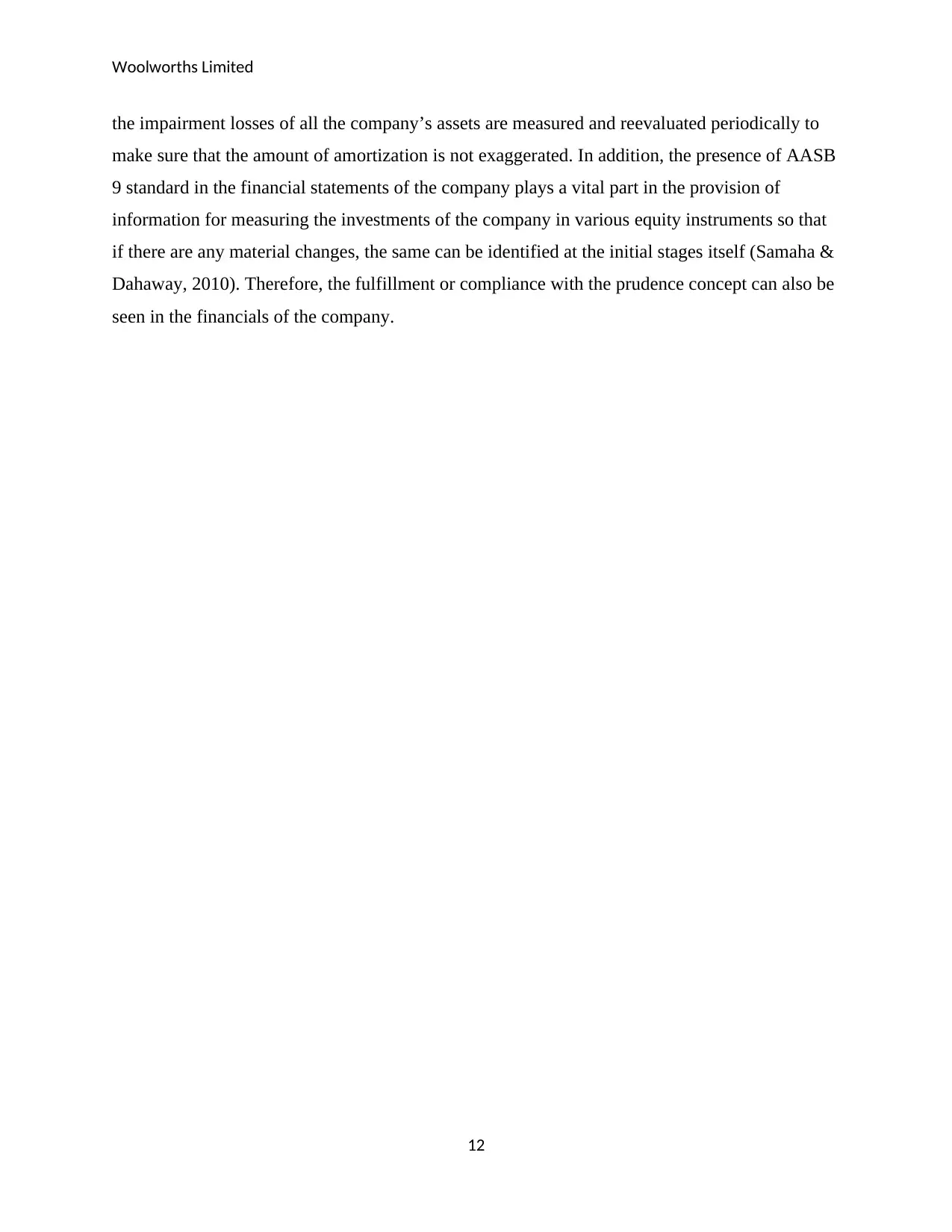
Woolworths Limited
the impairment losses of all the company’s assets are measured and reevaluated periodically to
make sure that the amount of amortization is not exaggerated. In addition, the presence of AASB
9 standard in the financial statements of the company plays a vital part in the provision of
information for measuring the investments of the company in various equity instruments so that
if there are any material changes, the same can be identified at the initial stages itself (Samaha &
Dahaway, 2010). Therefore, the fulfillment or compliance with the prudence concept can also be
seen in the financials of the company.
12
the impairment losses of all the company’s assets are measured and reevaluated periodically to
make sure that the amount of amortization is not exaggerated. In addition, the presence of AASB
9 standard in the financial statements of the company plays a vital part in the provision of
information for measuring the investments of the company in various equity instruments so that
if there are any material changes, the same can be identified at the initial stages itself (Samaha &
Dahaway, 2010). Therefore, the fulfillment or compliance with the prudence concept can also be
seen in the financials of the company.
12
⊘ This is a preview!⊘
Do you want full access?
Subscribe today to unlock all pages.

Trusted by 1+ million students worldwide
1 out of 15
Related Documents
Your All-in-One AI-Powered Toolkit for Academic Success.
+13062052269
info@desklib.com
Available 24*7 on WhatsApp / Email
![[object Object]](/_next/static/media/star-bottom.7253800d.svg)
Unlock your academic potential
Copyright © 2020–2025 A2Z Services. All Rights Reserved. Developed and managed by ZUCOL.





